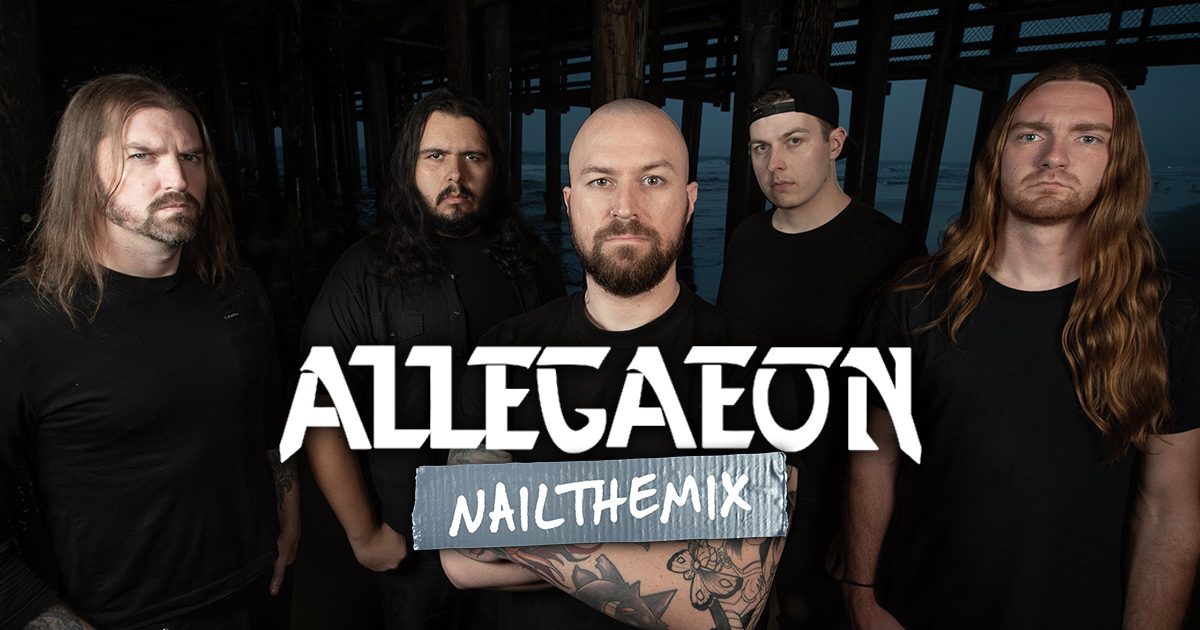
How to EQ Metal Guitar for a Modern Mix
Nail The Mix Staff
Let’s be real. Ask ten producers how to EQ metal guitar, and you’ll get ten different answers. You'll hear rigid rules like "always cut at 400Hz" or "always boost at 2.5k," as if it's a magic formula.
Here’s the truth: there is no formula. Every great-sounding metal record has probably broken every "rule" you've ever heard. The final EQ depends on the player, the guitar, the amp, the mics, the song's key, the bass tone… you get the picture.
But before we even touch a single EQ knob, we have to talk about the most important factor in any guitar tone: the performance. We're drowning in amazing plugins and modelers, but if you think a new piece of gear is the secret, you're missing the point. The reason modern metal guitars sound so damn clear and powerful is because the standard of musicianship, especially rhythmic precision, has skyrocketed.
A tight, consistent performance is your best EQ. It’s the foundation that makes everything else possible. This guide will give you a modern workflow and practical starting points, but always remember: your goal is to enhance a great performance, not fix a sloppy one.
The Real Foundation: Why Your Performance is 90% of the Sound
Ever wonder why the raw DI tracks from bands like Gojira or Periphery already sound incredible? It’s god-tier rhythmic precision. Every palm mute is intentional, every chug is locked to the grid, and the dynamics are unbelievably consistent.
When a performance is that tight, your job as a mixer becomes infinitely easier.
- Clean DIs: Tight playing results in clean, punchy DI tracks. This means when you reamp them, the tone is focused and powerful, not a washy, inconsistent mess.
- Less Mud, More Clarity: A sloppy performance creates all sorts of weird low-mid buildup and resonant frequencies that you have to fight with EQ. A tight performance is naturally cleaner, so you're not doing rescue surgery; you're sculpting.
- Enhancement, Not Correction: With a great take, you’re using EQ to bring out the good stuff that’s already there—the pick attack, the growl, the character. You’re not trying to create aggression that the player didn’t provide.
Your DAW is your best friend here. Before you even think about EQing, record a riff you think you know well. Now zoom in on the waveforms. Are your transients consistently hitting just before or right on the grid line? Or are they all over the place? This is your honest feedback loop. A tight performance is the bedrock of a killer metal guitar tone.
Ditching the Dogma: Start With Your Ears, Not Rules
Okay, you’ve got a killer performance recorded. Now it's time to EQ. The most important rule is that there are no rules. If it sounds good, it is good.
That said, you need a place to start. Think of the following steps as a reliable workflow, not a rigid set of instructions. The specific frequencies will always change, but the process is solid.
A Practical Starting Point: The EQ Workflow for Metal Guitars
Our approach can be broken into two main phases: cleaning up the mess (subtractive EQ) and then shaping the aggression (additive EQ). Always do your cuts first. You can't properly judge which frequencies to boost if you've got mud and fizz clouding your judgment.
Step 1: Subtractive EQ – Cleaning Up the Mess
This is where you carve away the frequencies that clash with other instruments or just sound plain bad. A great tool for this is a visual EQ like the FabFilter Pro-Q 3, but your stock DAW EQ is more than capable.
The High-Pass Filter (HPF): Taming the Low-End Rumble
Your guitars don't need all that sub-bass information. It just fights with the kick drum and bass guitar, creating mud.
- What it does: Cuts all frequencies below a certain point.
- Starting Point: Set a high-pass filter somewhere between 80Hz and 120Hz.
- How to dial it in: Slowly move the filter up while the full mix is playing. The second you hear the guitars start to sound thin or lose their "weight," back it off a little.
The Low-Pass Filter (LPF): Slaying the High-End Fizz
That harsh, static-like "fizz" on top of many high-gain tones is the #1 enemy of a professional-sounding mix. It makes guitars sound cheap and fights for space with the cymbals.
- What it does: Cuts all frequencies above a certain point.
- Starting Point: Start with a low-pass filter around 12kHz and slowly bring it down.
- How to dial it in: You’ll be surprised how low you can go. Sometimes as low as 8-9kHz. You want to remove that nasty, ear-fatiguing fizz without making the guitar sound dull. This single move can instantly make your tone more polished.
Hunting Down Problem Frequencies
Now for the surgical part. Use a narrow Q (bandwidth) on an EQ band, boost it significantly, and "sweep" it across the frequency spectrum to find ugly-sounding spots. When you find one, switch from a boost to a cut.
- The "Boxiness" or "Mud" (250Hz – 500Hz): This is the classic mid-scoop area. A cut here can clean up the guitars and make space for the snare and bass. Be careful not to cut too much, or you’ll lose all the body.
- The "Honk" or "Nasal" Tone (800Hz – 1.5kHz): Sometimes a cut in this range can make the guitars sound less like a cheap wah pedal and more aggressive.
- The "Harshness" (2.5kHz – 5kHz): This is a tricky area. It contains both painful harshness and essential pick attack. A surgical cut here can tame the ice pick sound without losing bite.
This is the core of modern metal guitar mixing. For a deeper dive into these concepts, check out our comprehensive guide on EQ Strategies for Mixing Modern Metal.
Step 2: Additive EQ – Shaping the Aggression
Once you've cleaned everything up, you can add some character back in with gentle boosts. If you feel like you need to boost a frequency by more than a few dB, the problem might be at the source (amp settings or mic choice).
- The "Bite" or "Pick Attack" (1.5kHz – 4kHz): A broad, gentle boost here can bring out the articulation and aggression of the picking, helping the guitar cut through the mix.
- The "Air" or "Presence" (6kHz – 10kHz): Be careful here. A very slight high-shelf boost can add some nice clarity, but it can also bring back the fizz you just worked so hard to remove. Use sparingly.
Context is Everything: EQing in the Mix
A guitar tone that sounds amazing in solo might completely disappear or, even worse, clutter up a full mix. Always make your final EQ decisions with all the other instruments playing.
- Guitars vs. Bass: Are they fighting for the same space in the low-mids? If the bass has a lot of gritty mids, maybe the guitars need a deeper scoop in that area, and vice-versa. They need to fit together like puzzle pieces.
- Guitars vs. Drums: Make sure the guitar's "bite" isn't masking the crack of the snare. The LPF you set earlier should be helping create a pocket for the cymbals to live in.
- Guitars vs. Vocals: This is the main reason for the classic mid-scoop. The vocal needs to own the midrange. Carve out a space for it to sit clearly.
Beyond the Single Track: Bus Processing
Once you have your individual rhythm tracks (e.g., your quad-tracked lefts and rights) sounding good, send them all to a single stereo bus or group. Here, you can apply broad-stroke EQ and compression to "glue" them together. A gentle EQ move on the bus can shape the overall character of the guitars as a single instrument. This is also where you can apply bus compression to make the guitars feel more cohesive and powerful.
This is a huge topic on its own, and mastering it can take your mixes to the next level. We cover it in-depth in our guide to Metal Compression Secrets.
From Guidelines to Greatness
Mastering guitar EQ isn't about memorizing frequencies. It’s about training your ear, starting with a killer performance, and having a solid workflow. Clean up the junk, enhance the good stuff, and always listen in context.
These techniques are the exact same fundamentals the pros use. But what if you could be a fly on the wall and watch producers like Will Putney, Jens Bogren, or Nolly Getgood dial in these tones on real songs from bands like Knocked Loose, Opeth, and Periphery?
That's exactly what we do at Nail The Mix. Every month, you get the raw multi-tracks from a massive metal song and watch the original producer mix it from scratch, explaining every single move. You get to see how they apply these EQ principles, how they solve problems, and how they make those creative choices that separate a good mix from a great one.
If you’re ready to go beyond the presets and learn how to truly sculpt professional metal tones, see how the pros unlock their sound with Nail The Mix.
Get a new set of multi-tracks every month from a world-class artist, a livestream with the producer who mixed it, 100+ tutorials, our exclusive plugins and more
Get Started for $1





